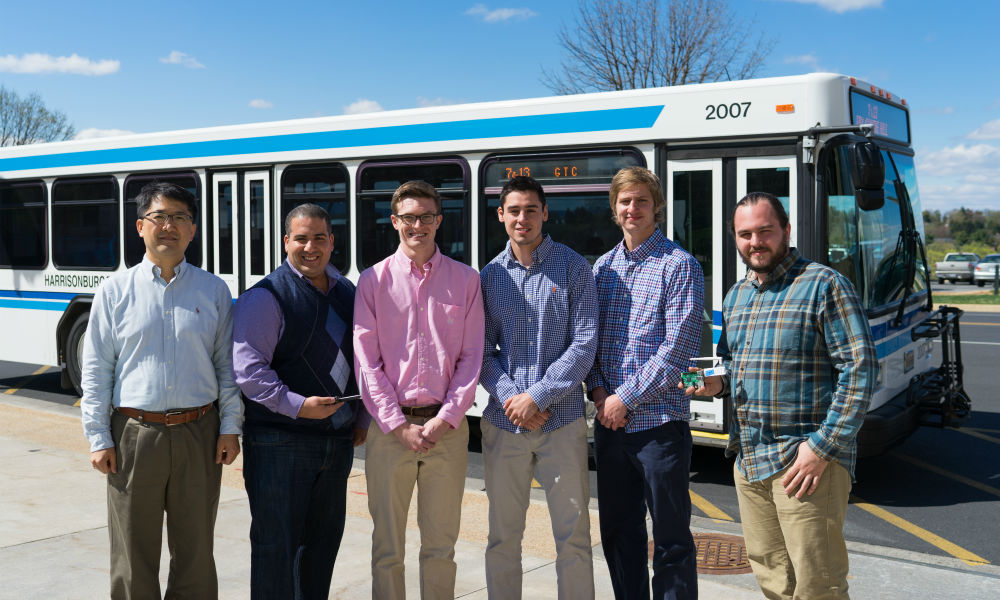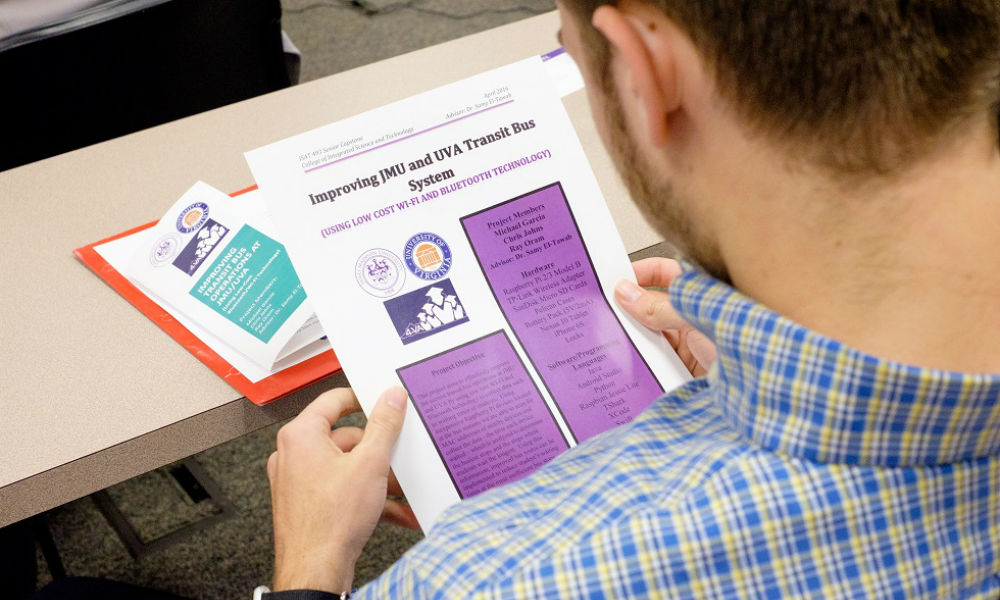Students aim to improve Harrisonburg Transit Bus System
College of Integrated Science and Engineering
SUMMARY: A team of ISAT and CS students focused their research on improving bus transportation for JMU students and the entire Harrisonburg community.
By Brett Seekford and Lynn Radocha
James Madison University (JMU) students know how important it is to get to their classes on time. With over 20,000 students and 148 buildings spanning 721 acres, students often experience bus delays and overcrowding.
As part of their senior capstone project, Ray Oram (‘16), Andrew Funkhouser (’16), Michael Garcia (’16), Chris Johns (’16), Kyle Evers (’17) and Kevin Olsen (’18), a team of Integrated Science and Technology (ISAT) and Computer Science (CS) majors, focused their research on improving bus transportation for JMU students and the entire Harrisonburg community.
“If you are a student at JMU, you have waited at a crowded bus stop for a single bus to come by and not be able to get everybody,” said Oram. “With this application, we hope to get buses where they need to be when they need to be there.”
The students, working with Samy El-Tawab, professor in the ISAT Program, utilize low-cost technology to meet the needs of their project. By installing smart nodes at several bus stops, they collect data on people waiting for a bus to arrive. This process required sensing smartphones using technology like Wi-Fi to track the length of time spent waiting.
“This project is perfect for ISAT students,” El-Tawab explained. “It encourages students to follow ideas in other fields of study and integrate it with their own concentration. It helps solve a problem found in daily life on campus and is a key component in achieving a more sustainable urban transportation system.”
The research endeavor, “Improving Transit Bus Operations Using Low-Cost Technology,” is a collaboration between JMU, Harrisonburg Department of Transportation (HDPT), the University of Virginia (UVA) and Charlottesville Area Transit (CAT). The research is made possible through a grant from 4-VA, who has provided $32,700 in funding over the course of two years.
While students from both universities are working on similar projects with their respective area transit departments, they benefit by meeting weekly and bringing together groups who have different ideas, approaches, experience and areas of expertise. Students share their innovations and compare outcomes across both institutions and make improvements based on results. El-Tawab believes this type of collaboration allows students and faculty at both institutions to learn from one another while also going their own way.
The project, in its second year, has proven beneficial in guiding transportation routes and schedules to decrease wait times. It has expanded from a senior capstone project to a long-term community partnership to install time-saving technology at multiple bus stops. El-Tawab has received requests from Harrisonburg City Transit System representatives for the expansion of the project to 18 additional bus stations on campus and around Harrisonburg.
Although Oram and Funkhouser graduated, they are still very involved as research assistants. They distribute tracking devices across the city while monitoring data collection to survey the efficiency of their research model. Funkhouser continuously looks for new ways to improve the longevity of the systems at the bus stations to ensure batteries do not have to be replaced as often. Funkhouser and Oram’s continued commitment to the project exemplifies the strong bond that so many ISAT alumni have for the ISAT program, for creating solutions and making a difference in the world.
With its focus on student development and community collaborations, the transit system study follows ISAT’s unique curricular model, known as the Holistic Problem-Solving Spine. This curriculum allows students to address real-world problems, employ critical-thinking skills gained in their classes, collaborate across schools and departments, and partner with the community.
“ISAT develops you into becoming a people person. You’re not only focusing on the project but how it impacts the community,” said Garica. “The project is going to benefit people in the long run, and to me, that is more rewarding than getting an ‘A’ on a project.”
The students presented their work at the 2016 IEEE Vehicular Networking Conference in Ohio, the 2017 IEEE International Conference on Pervasive Computing and Communications in Hawaii, the 2017 IEEE International Conference on Vehicular Electronics and Safety in Vienna, Austria and there is one paper currently under review.
“This work emphasizes the consideration, use, and development of science and technology to address compelling human problems as mentioned in the ISAT mission statement,” El-Tawab said. “The dreams of a professor come true when you see students taking a small idea to new heights.”
